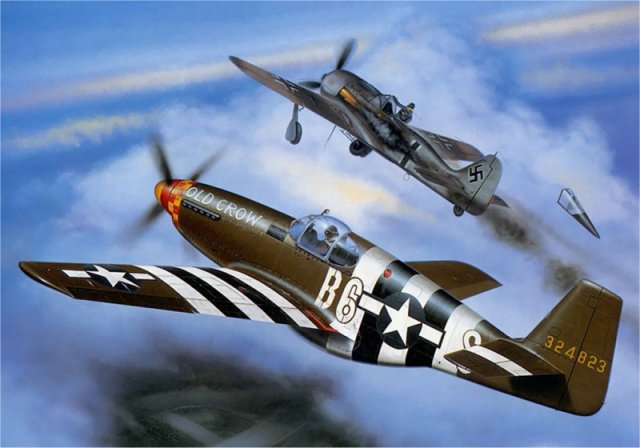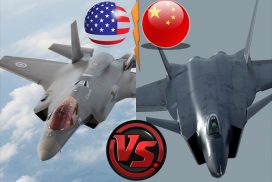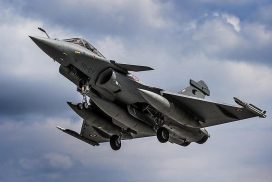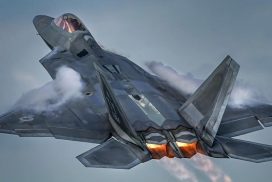Dogfights are forms of aerial combat between fighter aircraft or a manoeuvrings combat at short range, where each side is aware of the others presence. Dogfighting first appeared during World War I, shortly after the invention of airplanes, and has since become a component in every major war. However it was believed that after World War II, high tech combat aircraft with greater speed and longer range weapons would make dogfighting obsolete.
Modern terminology for air-to-air combat is air combat maneuvering (ACM), which refers to tactical situations requiring the use of individual basic fighter maneuvers (BFM) to attack or evade one or more opponents. This differs from aerial warfare, which deals with the strategy involved in planning and executing various missions.
Here is a list top 5 famous dogfights in history:
1 – F-15 vs Mirage F1 in Gulf War (1991)
 The Persian Gulf War (August 2, 1990 – February 28, 1991), commonly referred to as Gulf War, was a war waged by a U.N – authorized coalition force from thirty-four nations led by the United States and United Kingdom, against Iraq.
The Persian Gulf War (August 2, 1990 – February 28, 1991), commonly referred to as Gulf War, was a war waged by a U.N – authorized coalition force from thirty-four nations led by the United States and United Kingdom, against Iraq.
The Persian Gulf War started with an extensive aerial bombing campaign on 17 January 1991. The aerial combat mission was called Operation Desert Storm and the F-117 Stealth bombers aimed precise laser- guided bombs at key targets in Baghdad. The first priority for Coalition forces was the destruction of the Iraqi air force and anti-aircraft facilities. The United States immediately began a mobilization to the area by sending 48 McDonnell Douglas F-15 Eagles.
 F-15C, D and E models were also deployed in support of Operation Desert Storm where they proved their superior combat capability with a confirmed 26:0 kill ratio. F-15 fighters accounted for 36 of the 39 Air Force air-to-air victories. The F-15’s were used against the Mirage F1 and they achieved a high kill ratio.
F-15C, D and E models were also deployed in support of Operation Desert Storm where they proved their superior combat capability with a confirmed 26:0 kill ratio. F-15 fighters accounted for 36 of the 39 Air Force air-to-air victories. The F-15’s were used against the Mirage F1 and they achieved a high kill ratio.
F-15Es were operated mainly at night, hunting SCUD missile launchers and artillery sites and also hunting the Iraqi Aircrafts that included Antonov An-12 ‘Cub’,Dassault Mirage F1 and Mikoyan-Gurevich MiG 21MF ‘Fishbed-J’.
–
–
2 – A6M Zero vs Spitfire/Seafire
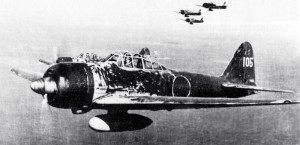 The Spitfire/Seafire and the A6M Zero were two of the most recognizable and iconic fighters of World War II.The “ZERO” was one of the best dogfighters of WWII. In a 1 on 1 it could out-turn and out-climb anything the allies had in the beginning of the war.Though these two aircrafts were constructed for very different purposes, the Seafire were used to fly from carrier decks and Zeros were being used as ground-based interceptors and suicide bombers.
The Spitfire/Seafire and the A6M Zero were two of the most recognizable and iconic fighters of World War II.The “ZERO” was one of the best dogfighters of WWII. In a 1 on 1 it could out-turn and out-climb anything the allies had in the beginning of the war.Though these two aircrafts were constructed for very different purposes, the Seafire were used to fly from carrier decks and Zeros were being used as ground-based interceptors and suicide bombers.
The Seafire had already proven itself during the Battle of Britain whereas the Zero gave the Japan air superiority at the beginning of WWII until the better developed Allied planes came along.
During WW2, dogfight was changed to “bounces” and quick-passes,boosted by team tactics. Maneuverability as in rate of turn was still an important asset, but fighters with powerful engines could run away,or climb their way out of an unwanted dogfight.This is why the biplane fighters,even thought they were more maneuverable than monoplanes, vanished from air combat during WW2. And this is how the American F4F Wildcats,later replaced by the better armored and faster Hellcats,achieved their victories against the nimble Zeros.
 A superior dogfighter than the early Allied fighters, the Zero was able to out-maneuver its opposition. To combat this, Allied pilots developed specific tactics for dealing with the aircraft. These included the “Thach Weave,” which required two Allied pilots working in tandem, and the “Boom-and-Zoom,” which saw Allied pilots fighting on the dive or climb. In both cases, the Allies benefited from the Zero’s complete lack of protection as a single burst of fire was generally enough to down the aircraft.
A superior dogfighter than the early Allied fighters, the Zero was able to out-maneuver its opposition. To combat this, Allied pilots developed specific tactics for dealing with the aircraft. These included the “Thach Weave,” which required two Allied pilots working in tandem, and the “Boom-and-Zoom,” which saw Allied pilots fighting on the dive or climb. In both cases, the Allies benefited from the Zero’s complete lack of protection as a single burst of fire was generally enough to down the aircraft.
During the course of the war, over 11,000 A6M Zeros were produced. While Japan was the only nation to employ the aircraft on a large scale, several captured Zeros were used by the newly-proclaimed Republic of Indonesia during the Indonesian National Revolution.
3 – F-4 Phantom II vs Mig-17 in the Vietnam War(1965-73)
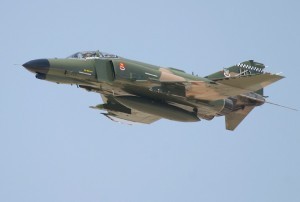 This historical aerial combat between American and North Vietnamese aircrafts was witnessed in the Vietnam war.This dogfight included the strengths and weaknesses of the two most iconic combat aircrafts in the Cold War.These aerial dogfights were mostly fought over the jungles of North Vietnam.
This historical aerial combat between American and North Vietnamese aircrafts was witnessed in the Vietnam war.This dogfight included the strengths and weaknesses of the two most iconic combat aircrafts in the Cold War.These aerial dogfights were mostly fought over the jungles of North Vietnam.
The F-4 Phantom II obtained outstanding results in the war and although it had its disadvantages in size,weight and maneuverability when compared with the MIG-17,the F-4 comprehensively defeated the MIG-17 “Fresco” in a series of battles in 1972.
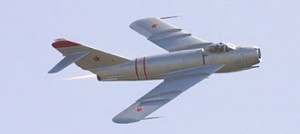 Tactics such as “lag pursuit”(aggressively manoeuvrings the F-4 outside the MIG’S turning circle and using its superior speed to achieve a firing range) gave pilots a real advantage over their opponents.
Tactics such as “lag pursuit”(aggressively manoeuvrings the F-4 outside the MIG’S turning circle and using its superior speed to achieve a firing range) gave pilots a real advantage over their opponents.
The F-4 Phantom II, was considered a lethal combat aircraft and became a successful weapon during the Vietnam War by maintaining the best kill ratio over North Vietnamese jets. The Phantom was a large fighter aircraft with a top speed of over Mach 2.
4 – PAF F-86 Sabres vs IAF Gnat (1971 Indo-Pak War)
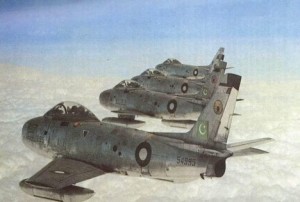 This aerial combat began on 22 November, 1971, several days before the formal start of hostilities. The first encounter was so dramatic and happened in full view of so many ordinary people on the ground that it would endure in public memory as one of the most vivid moments of the war.
This aerial combat began on 22 November, 1971, several days before the formal start of hostilities. The first encounter was so dramatic and happened in full view of so many ordinary people on the ground that it would endure in public memory as one of the most vivid moments of the war.
The scene of action was in the eastern sector, a few minutes flying time away from Calcutta, the largest Indian metropolis in the east. The provocation was the repeated intrusion by groups of PAF F-86 Sabres into a salient inside Indian territory. This salient called Boyra was being used by Bangladeshi Mukti Bahini guerrillas to launch attacks inside East Pakistan. The Pakistani Army in the east had reacted angrily by launching a full scale attack in that sector but had had to beat a retreat after losing 13 tanks and many men. The job of messing up the Mukti Bahini was given to the PAF Sabres which began crossing into Indian territory, strafing the area and slipping back into Pakistani air space. The IAF had to get them while they were in Indian air space. The window was small: barely a couple of minutes wide, and the PAF fighters had to be intercepted over a 3 km wide corridor surrounded on three sides by Pakistani territory.
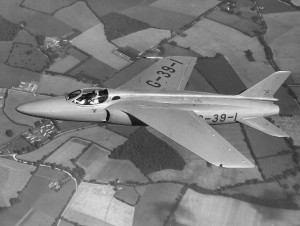 Four IAF Gnats were ordered to scramble at about 2:49 pm on 22 November to take on four Sabres strafing the Indian territory. The Gnats got three Sabres. The IAF formation leader, Flight Lieutenant R. Massey; Flight Lieutenant M. A. Ganapathy and Flying Officer D.Lazarus each got one Sabre. One Sabre crashed into a pond in Chaugacha on the East Pakistani side of the border, while the other two went down over Indian territory. Flt. Lt. Parvez Mehdi Qureshi and Fg Offr Khalil Ahmed, the two PAF pilots who ejected over India were captured and produced before a crowded press conference the next day. The action was splashed in newspaper front pages all over the country and the three pilots who scored hits became national heroes overnight. This encounter set the tone of the air battles that were to follow. News of the incident and the famous gun camera shots were splashed across newspaper headlines the world over and the tiny Gnat acquired a reputation of being the Sabre killer.
Four IAF Gnats were ordered to scramble at about 2:49 pm on 22 November to take on four Sabres strafing the Indian territory. The Gnats got three Sabres. The IAF formation leader, Flight Lieutenant R. Massey; Flight Lieutenant M. A. Ganapathy and Flying Officer D.Lazarus each got one Sabre. One Sabre crashed into a pond in Chaugacha on the East Pakistani side of the border, while the other two went down over Indian territory. Flt. Lt. Parvez Mehdi Qureshi and Fg Offr Khalil Ahmed, the two PAF pilots who ejected over India were captured and produced before a crowded press conference the next day. The action was splashed in newspaper front pages all over the country and the three pilots who scored hits became national heroes overnight. This encounter set the tone of the air battles that were to follow. News of the incident and the famous gun camera shots were splashed across newspaper headlines the world over and the tiny Gnat acquired a reputation of being the Sabre killer.
The IAF’s primary interceptor continued to be the Folland Gnat, a tiny but highly maneuverable aircraft that had been passed over by its British manufacturers. The Gnats flew the highest number of sorties during the war.
The PAF’s mainstay was the F-86F Sabre, which was in service with many NATO countries although it belonged to a line that had been in production since the time of the Korean War. The Sabre was an excellent aircraft and had been substantially modified over the years to keep up with evolving Soviet combat aircraft. The Indians rated the Mirage-III as the best PAF fighter but that aircraft was not seen as much as it was hoped. The IAF, despite its superiority in numbers, knew it would be a tough fight but was fully prepared for a no-holds barred contest.
5 – Arab MIG-21s vs Israeli Mirage IIICJs
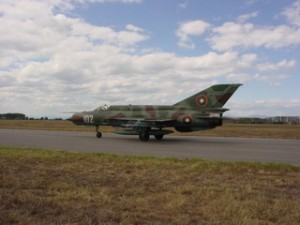 The Mikoyan-Gurevich MiG-21 was the Mach 2 successor of the subsonic MiG-9, the transonic MiG-15 and MiG-17 and the supersonic MiG-19, just as the Mirage III had evolved from the subsonic Ouragan, the transonic Mystere and the supersonic Super Mystere. Of all the Mach 2 fighters developed in the early 1950s, the MiG-21 and the Mirage III had more in common than any other pair. They were
The Mikoyan-Gurevich MiG-21 was the Mach 2 successor of the subsonic MiG-9, the transonic MiG-15 and MiG-17 and the supersonic MiG-19, just as the Mirage III had evolved from the subsonic Ouragan, the transonic Mystere and the supersonic Super Mystere. Of all the Mach 2 fighters developed in the early 1950s, the MiG-21 and the Mirage III had more in common than any other pair. They were
created over a similar time-frame in a development process that shared many concepts – both were expected to overcome propulsion weakness through light weight and fine-tuned aerodynamics.
As a result, the MiG-21 and the Mirage III had comparable performance, despite the latter boasting a delta wing while the Soviet fighter had both a delta wing and a conventional tailplane. The Israeli Mirage IIICJs engaged Arab MiG-21s at least 25 times between July 19, 1964 and June 10, 1967. Some of these encounters were only fleeting, while others evolved into fully blown air combat.
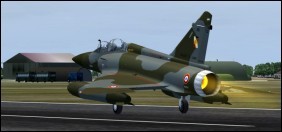 Victories were claimed or credited during 17 of these engagements.The participation in a successful air combat was no guarantee that an individual pilot would achieve a kill credit. The MiG-21-to-Mirage IIICJ combat loss ratio was 16:1. Around 22 of the 23 MiG-21 kills credited to Shahak(Mirage) pilots in 1966-67 were claimed with cannon – the other victory was a “no weapon” maneuver kill. Conversely, three of the five Shahaks lost to MiG-21s during the same period fell to “Atoll” AAMs.
Victories were claimed or credited during 17 of these engagements.The participation in a successful air combat was no guarantee that an individual pilot would achieve a kill credit. The MiG-21-to-Mirage IIICJ combat loss ratio was 16:1. Around 22 of the 23 MiG-21 kills credited to Shahak(Mirage) pilots in 1966-67 were claimed with cannon – the other victory was a “no weapon” maneuver kill. Conversely, three of the five Shahaks lost to MiG-21s during the same period fell to “Atoll” AAMs.
The remaining two were again “no weapon” kills – one jet was downed by the debris from an exploding MiG-21 and the other ran out of fuel. The fact that the Shahak boasted two cannon and adequate ammunition gave the jet a real advantage over the MiG-21 during the 1960s, as AAM technology was still then in its infancy. The MiG-21 and Mirage IIICJ were perhaps the most closely matched Mach 2 fighters to have ever gone head-to-head in combat. Nevertheless, the French machine emerged the clear victor with an air-to-air kills-to-losses ratio of 6-to-1, and a total combat losses ratio of 16-to-1 thanks to the Shahak’s superiority in air-to-air weaponry.

